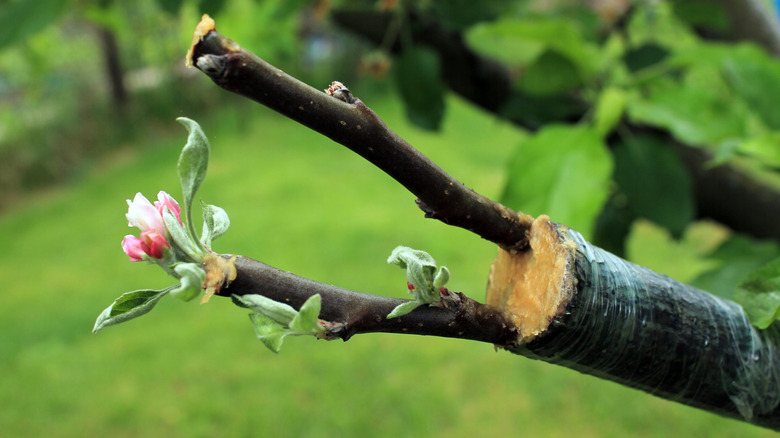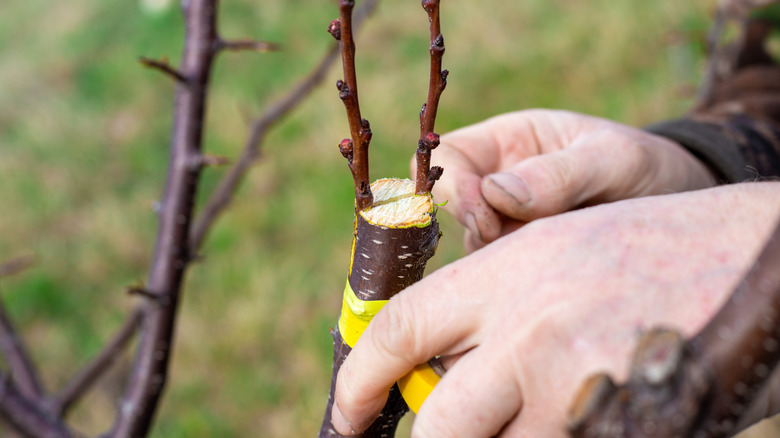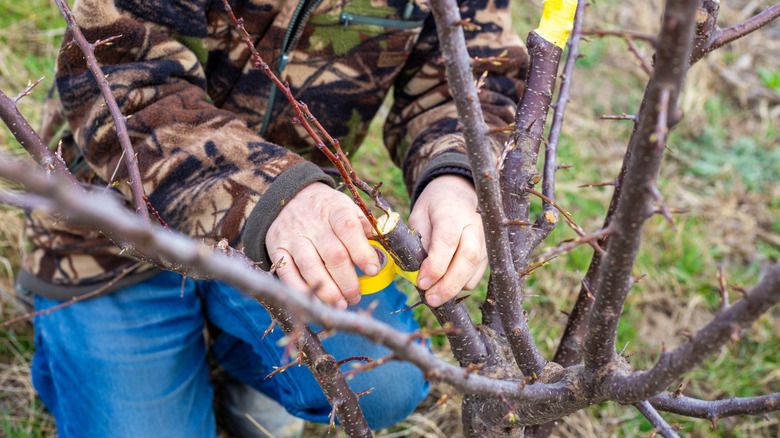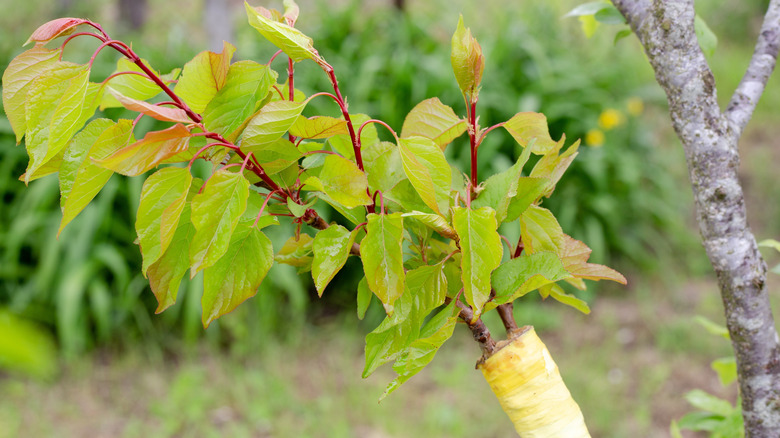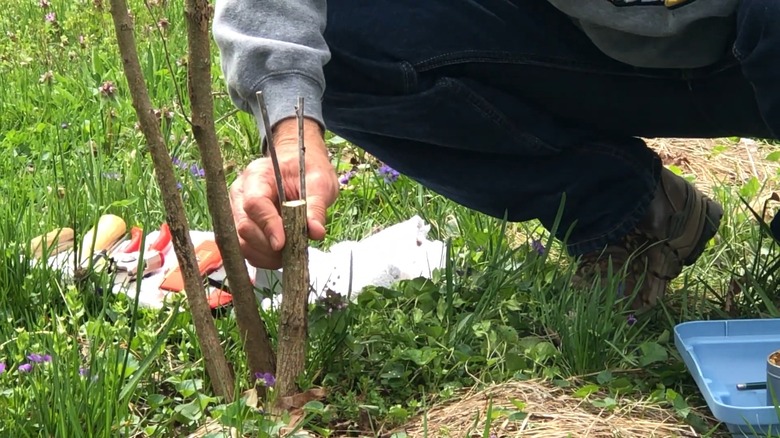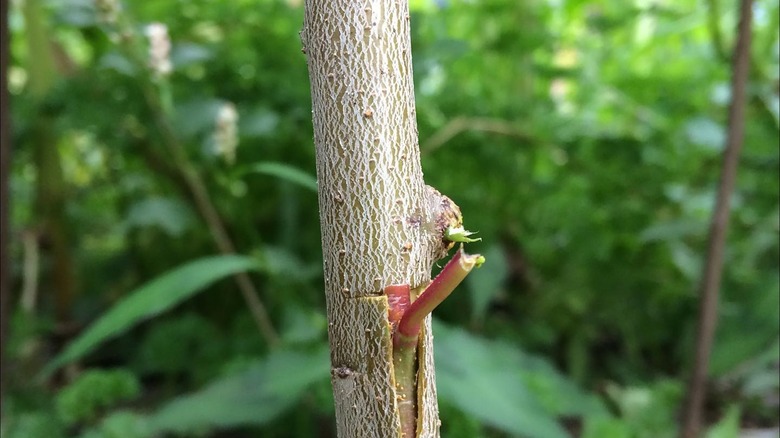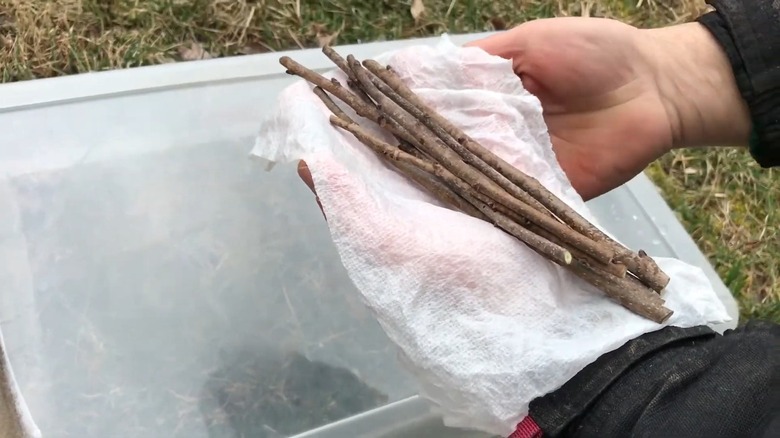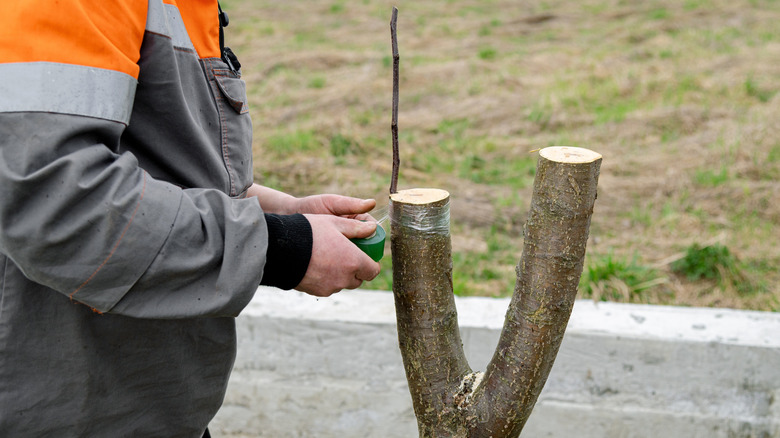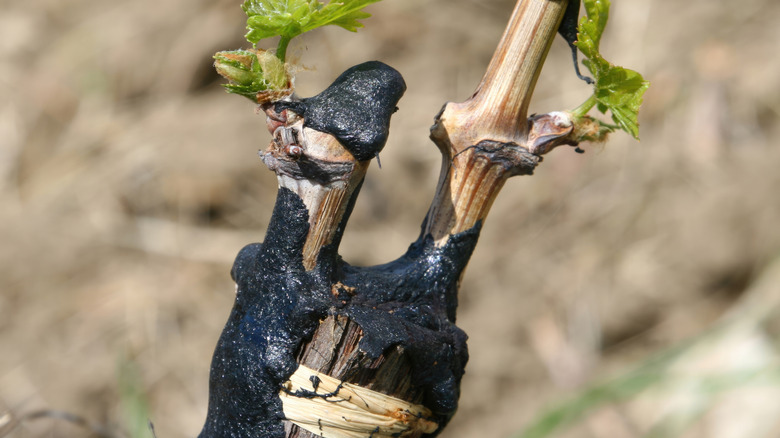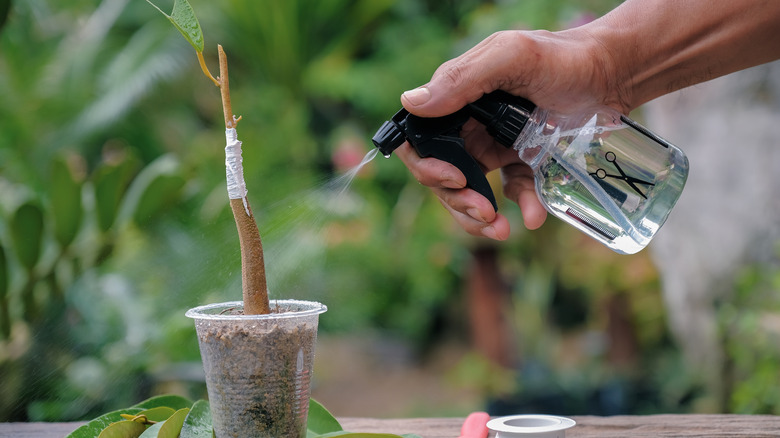A Beginner's Guide To Grafting Fruit Trees (And Common Mistakes To Avoid)
We may receive a commission on purchases made from links.
Loved the cherries from your grandma's orchard but can't get their seeds or root cuttings to establish? Perhaps, you've sacrificed your dreams of planting a fruit orchard in your yard, because arranging male pollinators for your trees has exhausted all real estate. Or maybe you want to upgrade a frail or diseased tree with a superior cultivar without spending too much cash? Fortunately, with a bit of patience, persistence, and skills with knives (pocket knives work, too), you can resolve these gardening woes by learning grafting. With enough practice, you can even grow multiple fruits at once by creating a fruit salad tree on a single specimen, like Sam Van Aken's fascinating "Tree of 40 Fruit."
But, first things first: What is tree grafting? It's essentially the joining of different, but compatible, cultivars together into a single tree through merging the cambium layers, which is the vascular tissue between the resource-carrying xylem (the outer sapwood) and the phloem (the inner bark). Essentially, you select one variety whose fruits you like. Then, you insert it into another variety with a hardy root system (called a "rootstock" or "understock"). If they successfully fuse, you will have got yourself a grafted tree, provided you follow the guidelines and steer clear of common mistakes. While you can buy specialized grafting tools, some basic implements like a saw, pruning shears, and a sharp knife are enough to get you started. You'll also need to pick up some grafting paint or wax.
Are your selected varieties compatible?
Grafted trees often fail due to the incompatibility between the rootstock and scion (the grafted on piece of twig or shoot). Even when fruit trees belong to the same genus, two different species may not combine well, and the grafted tree may have reduced vigor or delayed fruit production. So, it's best to graft the stock and scion from the same species. For best success, combine common fruit tree cultivars like apples, cherries, juneberry, autumn olives, and plums with a rootstock from the same species. The same goes for uncommon fruit trees you can grow in your garden, like pawpaw, fig, goumi berry, buckthorn, jujube, and filbert.
However, if you want to mix and match, try pome fruits like pears since they work well with quince, apple, or hawthorn stocks. Different citrus tree species tolerate each other, too. The Prunus genus offers the best results, as most of its inhabitants, like apricots, nectarines, and peaches, go well together. To create multi-grafted trees (where you have multiple different types on one rootstock), stick to stone fruits. Remember, maintaining them can be tough as the more vigorous scions may take over unless pruned severely. You can combine incompatible fruit trees (or those from different genera) if you can find the right "interstocks" — which are essentially a "third plant" playing the go-to between the scion and stock — but this is an advanced technique.
Nailing the rootstock selection
The way your grafted tree uptakes nutrients, tolerates environmental stressors, handles pests, anchors itself into the dirt, and performs in its chosen location depends on the rootstock. In fact, if you select the right rootstock based on your region and preferences, you can grow fruit trees that wouldn't survive in your landscape due to hostile conditions like poor drainage or heavy soils.
To illustrate, growing an apple tree on seedling rootstock or "standard" stocks will result in a tall tree unsuitable for most home gardens. Plus, it will take time to bear fruit, diminishing the excitement of growing and caring for an apple tree. Fortunately, multiple types of dwarfing varieties like M.7, M.26, and Bud 9 have been introduced to the market. Choosing one of these ensures your tree will be appropriately scaled and bear fruits sooner than the standard counterparts. However, dwarfing varieties are more expensive and can't repel deer due to their short stature. So, pick a rootstock after considering its pros and cons. Moreover, ensure it's cold hardy to your zone. Also, look for varieties that can withstand your area's pest and disease pressure. For example, peaches can be grafted on 'Nemagard' rootstocks in nematode-infested areas. To buy a rootstock, enquire at a local nursery. You can of course use an existing fruit tree in your yard as a rootstock. Unless you know the variety, the results will be a little less certain — but grafts of the same species are still well worth a try. For instance, if you tried growing an apple tree from seed and ended up with a wild apple, you can graft desirable apple cultivars onto
Sourcing the right scion
If you're buying scions, all you have to do is select a variety that's compatible with your rootstock. However, if you're harvesting your own scion wood (instead of getting it from a nursery or friendly exchange), ensure it meets certain criteria. For starters, scions should come from disease-free plants and shouldn't be from trees that are more than 8 to 10 years old (this ensures that the selected tree isn't carrying a pollen-borne virus).
Ideally, your selected scion should be a year old, since others may be too dry for grafting. Also, it should be about 8 inches long and have pencil-level thickness (between ¼ and ½ inch diameter), save for pecan trees that require thick scions. Plus, they should be straight-wooded with space between the buds. Avoid any wood supporting flowering buds, though it may not be possible for nectarines and peaches, whose vegetative buds grow alongside flower buds in clusters. Also, ignore water sprouts (suckers from dormant buds), as they lack adequate carbohydrates to ensure healing. Finally, cut your scion before the dormant tree wakes up and buds out for spring growth.
Use whip and tongue grafting to add more varieties to fruit trees
To successfully graft your fruit trees, it helps to know the different techniques you can employ, since each serves different purposes. If you're trying to grow a fruit salad tree or extend your existing one's harvest season by adding more varieties, opt for whip and tongue grafting. For this, ensure the scion and stock share the same width (between ¼ and ½ inch). This way, their cambium tissues will align better, resulting in a strong union that's quick to heal.
Since the grafting cuts must fit together seamlessly, use a sharp knife to achieve smooth cuts. Grab your rootstock and pick a spot at least 2 inches above the roots, sans any suckers. Make a 1½ inch long diagonal cut (or 2½ inches if it's especially thick). Next, move around ⅓ inch down from the initial cut to make the back cut — the whip. Slowly rock the knife parallel to the first cut (not the grain) to make a ½ inch long cut. Repeat the process for your scion, ensuring those cuts are made at its bottom (not the top), or the graft will fail. Once the cuts interlock together, cut your scion down to three buds, or it will use up excessive energy. Finally, wrap the union with parafilm or grafting tape (such as this NAYE Grafting Tape for Fruit Trees) to hold the pieces together and prevent drying.
Four-flap graft is a beginner-friendly technique for young trees
When space is at a premium, it's best to grow small trees that won't overtake your yard. So, you may select a seedling rootstock with a small caliper size — which is the measurement of the trunk's diameter 6 inches off the ground. Or, you might want to add variety to a young fruit tree (especially pecans) with a robust root system and 1-inch-wide small branches. Under such circumstances, elect the four-flap or banana graft method. It's easy to use and only requires a sharp knife, a rubber band, and wrapping materials.
Like whip and tongue, select stocks and scions sections with roughly the same diameter, no greater than 1 inch. However, unlike the former method, it's fine if the scion is a tad larger during grafting. In a planted stock, select a straight-grained limb and shear it down to 6 inches so the co-joined pieces won't break and splinter apart from environmental stressors. Next, pull a rubber band halfway down, make four parallel cuts, and peel back the four bark flaps with your knife, similar to how you'd peel a banana. Don't cut into the wood, as you can shear it off directly. Replicate the 1½-inch long cuts on your scion (leaving thin bark slices on the corners), going deep enough that the white wood tissue is exposed. Insert the scion and roll up the rubber band. Cover the union with aluminum foil and wrap it in a similar-sized polythene bag. Seal the scion's top with glue.
Utilize a bark graft technique for older trees
Use bark or veneer grafting if your yard harbors obsolete or invasive fruit trees (think Bradford pear) and needs an upgrade. The technique is also appropriate for trees with wider branches (over 1 inch thick) where banana grafting isn't possible. If you're buying scions, bark grafting can be slightly more expensive since it requires multiple scions to speed up the healing process.
First, you'll need a saw to shear off limbs and reveal the trunk. Make 2-inch long cuts with a knife at the rootstock's edge to create flaps that can hold the scion in place and replicate the cuts every 3 inches. The width of the flaps will depend on the circumference of your scions. For the scion, cut it 1 inch above its bottom edge without harming any vegetative buds. Next, slice off a 1½-inch long diagonal section so it fits snugly against the rootstock with its buds facing outwards. If required, give it a short cut on the other side, too. Ideally, you'll be left with a 6-inch-long scion with three buds. Gently peel down the bark from the stock, push the scion down, and finalize the joint with a nail or tape. Seal the grafting union and the scions' tips with grafting paint.
Topwork fruit trees through cleft grafting
Another way to change your existing fruit tree's variety is to use cleft grafting (which is called topworking). You can use this method on the truck of younger trees, and if the tree is older, you can also graft the scion onto an appropriately sized branch. But choose upright branches, as they receive more sunlight, and the increased sap flow can improve the odds of your graft taking. Also, prepare at least two scions.
For juvenile trees, cut the stem to about 30 inches above ground. Try to make a clean cut. You can trim any ragged edges with a knife. Next, use a mallet or hammer to drive a clefting tool or a butcher's knife down across the center of the trunk or branch end, creating a 2- to 3-inch deep cleft. Now, grab a ¼-inch-wide, scion that has three buds, and cut off 1½-inch-long diagonal slices on both sides. Angle the cuts slightly keeping the side with a weaker bud slightly thicker (this side should face outward when you insert the scions into either side of the cleft, matching the cambium layers (not the edges). Seal the cuts with grafting paint or grafting wax. The two scions will stick out of the edges of the cleft, as pictured above.
Side-veneer graft when cleft grafting isn't an option
Side-veneer, stub, or side graft is another technique that fills in the gap for fruit trees unfit for bark or cleft grafting because their rootstocks are under 2 inches wide. Although side-veneer grafts are typically used for conifer trees, fruit trees like mulberries and citrus trees adapt well to this method.
Start with a ¼-inch wide scion of your choosing. Ensure it's at least 3 inches long and supports three vegetative buds. Cut it diagonally on both sides, giving it an arrow-shaped look, similar as for cleft grafting. However, the cuts for side grafting should be shorter, maxing out at 1 inch. Halfway down the selected understock, make a diagonal cut and place the scion inside. Again, try to match the cambium layers, even if you have to angle the scion instead of putting it flush. Apply grafting wax to seal up the graft site. You don't need to tie the pieces together, however, you cover it in plastic wrap if you're unsure about the union. Trim the rootstock's top growth so it measures 6 inches long after the graft. Once the grafted scion starts budding (usually in about six weeks), remove all growth up to graft union and seal the cut.
Try the budding technique during the active growth season
Most grafting is carried out when both the rootstock and scion are dormant. However, a technique called budding comes into the picture when fruit trees, especially apples, pears, and peaches, are actively growing. Best of all, it doesn't require extensive cuts. You can also make more attempts, but start early, so the buds grow out before winter sets in. For budding, you will need to select a scion from the current year's growth (a fresh stem with new leaves on it is ideal).
There are two ways to go about budding: T-budding and chip budding. For T-budding, you slice a T-shaped cut that's 1½ inches long and ½ inch wide into the bark of a rootstock that's reached at least pencil-thickness in size. Don't forget to remove suckers from the selected stock. Now take your scion, and make a shallow cut that begins about an inch below the bud and terminates ½ inch above it. You basically want to shave off the bud. If there is a leaf on the bed, snip it off, but leave the stem of the leaf intact and sticking out of the bud. Insert this cut bud into the T-shaped cut on your rootstock and wrap the bond with budding tape.
Chip budding is another way to graft temperate fruit trees, like cherries and apples, when their bark isn't slipping and doesn't want to peel away easily. The unions are also often stronger and enjoy better resistance to cold. Start by making a ⅛-inch deep cut at a 45- or 60-degree angle slanting down into the rootstock and another starting roughly ¾ inch higher and meeting with the first cut to create a pocket. From here, follow the same steps as for T-budding, and seal up the graft.
Avoid: Letting your scions dry out before grafting
Frost-free environments allow for scion harvesting before the trees start budding in spring. But if you live in an area that gets frost, cut the scions from dormant fruit trees before the mercury dips to freezing temperatures. Since you must wait for spring's arrival to do the grafts, you'll need to store your scions in a cool environment where they won't dry out. To start, cover your scion wood in damp — not soaking wet (too much moisture can trigger mold) — paper towels.
You can also smear the tips with grafting wax to prevent premature drying. Next, take a freezer bag or watertight container, fill it with moist wood shavings or sawdust, and place the wrapped scions inside. Label the bags if you're storing more than one variety and place them in a refrigerator that's set to around 32 degrees Fahrenheit. Ensure the scions aren't in the vicinity of fruits or vegetables, because fresh produce can emit ethylene gas that may turn the buds on your scions permanently dormant. To ensure success, take longer scion cuttings so you have the option to remove the top and bottom sections that are prone to drying out. Longer scions between 14 and 18 inches are also best for bark grafting. Sealed bags can remain fresh in the refrigerator for half a year, (just make sure they do not freeze).
Avoid: Grafting at the wrong time
Grafting a fruit tree at the wrong time will lower your chances of success. Pay attention to the species, grafting technique, and the weather before making a decision. For instance, if you've zeroed in on budding, peach trees can be grafted via this method in June. But for dogwoods, you must wait until August, so their buds can mature. On the flip side, if you want to do scion-based grafting, wait until early spring (or the end of winter), because you'll require dormant scions and rootstocks.
Even then, the window for grafting will vary widely across different methods. For instance, cleft grafting is best done early in the season when the rootstock is just starting to wake up and the buds are swelling, whereas whip and tongue grafting may be more successful for certain types of fruit trees when done even earlier, while the rootstock and scions are still dormant. Conversely, four-flap and bark grafts depend on the bark being able to "slip", which occurs during the active growing season. Slipping refers to the bark's ability to peel off easily without any damage — a critical requirement for the successful integration of the scion in the understock. Although this window can last throughout the growth season, droughts or strong winds may cut it short, so plan your grafts accordingly.
Avoid: Removing seals too early
One aspect common to all grafting techniques is the need to seal the grafting or budding union along with any exposed cuts on scions. Because if you don't, the bond may dry out before the scion takes, resulting in graft failure. Plus, the union may fall apart without the seal's added support. These same risks apply if you remove the seals too early.
Some methods, such as side-veneer and whip and tongue grafting, require additional binding support to hold the grafted pieces together. You might need to remove the binding material and seals when the scion exhibits signs of growth to prevent stem girdling. However, once the temperatures peak in the summer, the grafted area may dry out without the seal. Moreover, it denies the fruit tree protection from extreme weather changes. So, be patient and give the seals at least one season before removing them in mid-summer or fall. You can even leave them on until spring next year for banana grafts. Budding is an exception to this rule. While budding tape and rubbers generally decompose of their own accord, they may not do so in time for a fast-growing fruit tree. For particularly fast growers, remove the binds after about three weeks.
Give your grafts good aftercare
Without aftercare, your grafting efforts will be for naught. Most grafting unions are brittle and may come undone, despite the seals. So, whenever possible (especially with seedling rootstocks), keep them potted during the first growth year in a sheltered location. This way, they won't get bumped by wind, rain, wildlife, pets, or kids. Staking may be necessary for top-worked trees since they grow fast, destabilizing the bond before it has healed completely. This may also keep the birds from perching and damaging the scion, provided the stakes are taller than the tree's height.
Moreover, keeping the graft moisturized is essential for the scion's taking. Shield your fruit tree from direct sunlight to keep it from drying out. Also, maintain a regular irrigation schedule. To minimize the risk of the rootstock leafing out, regularly rub off or shear any suckers. Remember, any delays will leave your plants (especially budded trees) swamped with unsightly scars (doglegs) later. For certain techniques like whip and tongue and bark grafts, prune secondary or non-vigorous shoots to divert the plant resources to the strongest shoot. For trees budded at the summer's beginning, remove the top stock once the scion buds break out to allow their take over. You can delay this process to next year's spring for late summer budding.
